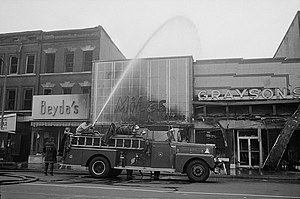1968 Washington, D.C. riots
| 1968 Washington, D.C. riots | |||
|---|---|---|---|
| Part of the King assassination riots | |||

A firetruck douses smoldering shops burnt out during the riots
|
|||
| Date | April 4, 1968 – April 8, 1968 | ||
| Location |
Washington, D.C., U.S. 38°55′01″N 77°01′55″W / 38.91694°N 77.03194°WCoordinates: 38°55′01″N 77°01′55″W / 38.91694°N 77.03194°W |
||
| Causes | Assassination of Martin Luther King, Jr. | ||
| Methods | Rioting, race riots, protests, looting, attacks | ||
| Parties to the civil conflict | |||
|
|||
| Casualties | |||
| Death(s) | 12 | ||
| Injuries | 1,098 | ||
| Arrested | 6,100+ | ||
![]() District of Columbia government
District of Columbia government
Washington, D.C. riots of 1968 were six days of riots that erupted in Washington, D.C., following the assassination of civil rights activist Martin Luther King Jr. on April 4, 1968. The King assassination riots affected at least 110 U.S. cities; Washington, along with Chicago and Baltimore, were among the most affected.
The ready availability of jobs in the growing federal government attracted many to Washington in the 1960s, and middle class African-American neighborhoods prospered. While the black middle-class community prospered, the lower class was plagued by poor living conditions and fell deeper into poverty. Despite the end of legally mandated racial segregation, the historic neighborhoods of Shaw, the H Street Northeast corridor, and Columbia Heights, centered at the intersection of 14th and U Streets, Northwest, remained the centers of African-American commercial life in the city.
...
Wikipedia
